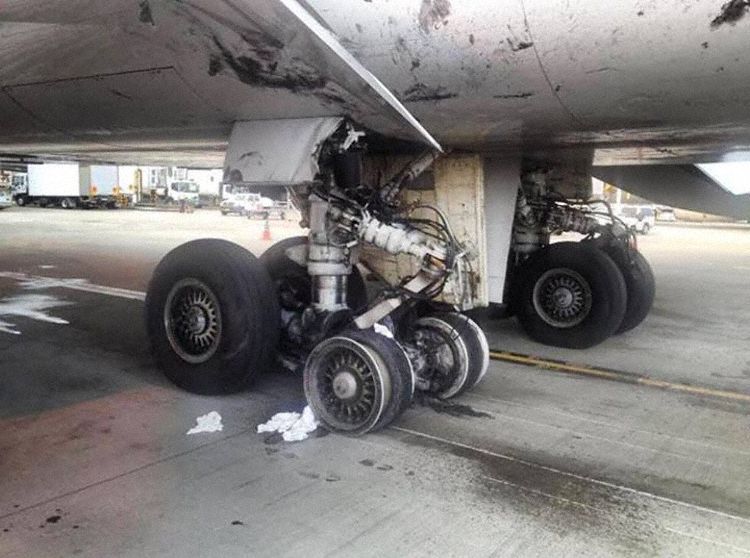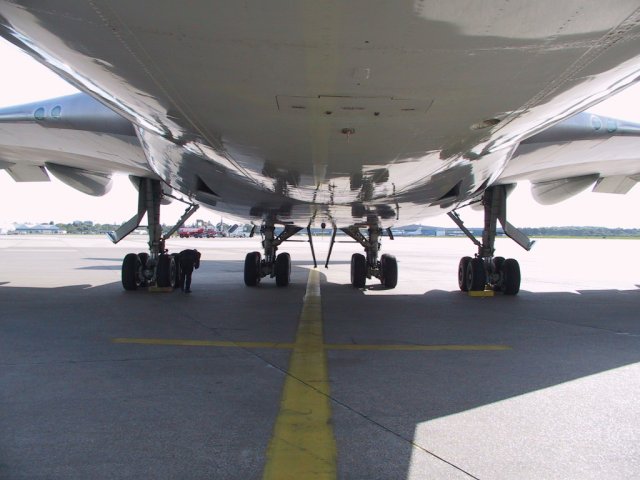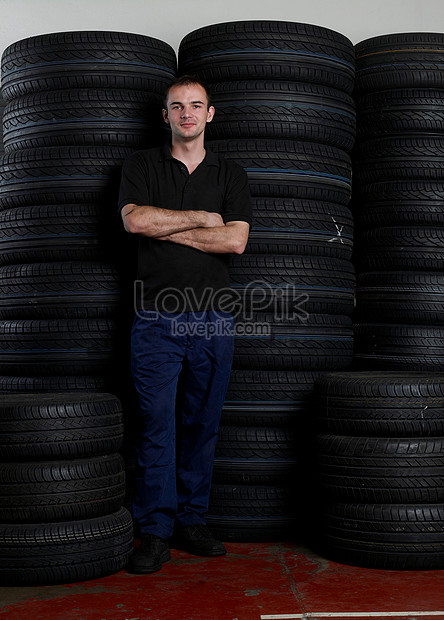Tires are a fascinating and vital part of the aircraft, but not something we often discuss. It's clear to see that most commercial jets have a large number of wheels as part of the main and front landing gears. But from a distance, it can be hard to see exactly how many. Let's see which aircraft have the most.
The Antonov-225 come first in many things. The largest commercial aircraft flying and the highest cargo payload are its top accolades. It also comes top, by a long way, in the number of tires. This impressive aircraft has a total of 32 tires. It has seven wheel long landing gears on each side.
The Antonov An-225 has 32 tires. Photo: Getty ImagesThere is only one Antonic-225 in service, A second was partially built, and there has been some discussion about completing it. This seems unlikely, though.
Antonov An-225 is back in action. Photo: Dubai AirportsIts smaller series companion, the Antonov-124, comes in second place, both for cargo lifting ability and number of wheels. It has a mere 24 wheels across its gears. The An-124 also has specially adapted landing gear struts to allow for landing on rougher ground and the ability to bend to lower the aircraft for easier cargo loading.
Following on from the Antonov aircraft, it is not surprising that the heavier passenger aircraft have the most ties. The Airbus A380 has 22 wheels across its main and front landing gears.
The landing gear on an Airbus A380. Photo: arpingstone via WikimediaMoving down other widebodies, the Boeing 747 comes next with 18 tires. There is a jump down to the Boeing 777, with 'just' 14. It has much larger tires, though. And it gets less with the 787 too, with 10 tires.
The main landing gear on a Boeing 747. The tilted angle is common and ensures proper storage of the gear. Photo: Arpingstone via Wikimedia Photo: Getty ImagesAs for Airbus widebodies, after the A380, the A350-1000 has 14 tires (with a three-wheel long main gear), and the smaller A350-900 reduces this to 10.
The A340 has an unusual additional middle landing gear (two wheels on the A340-200/300 and four on the A340-500/600), for a total of 12 or 14 tires. The A330 has just 10 tires (as does the A300 and A310).
The A340 has a middle landing gear. Photo: Bahnfrend via Wikimedia CommonsOf course, with smaller and lighter narrowbodies come fewer wheels and tires. The Boeing 757 has the most, 10 wheels with four on each main landing gear. It shares this setup with the widebody 767.
All Boeing 737 aircraft have six wheels (two on each main gear and two nose wheels), as does the A318, A319, A321, and most A320 aircraft.
Most narrowbody aircraft have six tires. Photo: Vincenzo Pace | Simple Flying.Interestingly, some Air India A320s have additional wheels on the main landing gear. This is due to the lower classification of some airport runways, meaning aircraft need extra wheels to spread the aircraft weight.
Some of Air India's A320 have additional wheels on their landing gear. Photo: Steven Byles via Flickr
Photo: Steven Byles via Flickr Why have so many wheels, and why are they so large? The primary function of the landing gear, of course, is to take the force of the landing aircraft and prevent any contact between the fuselage and ground. More wheels spread the force of the landing between them. They also provide redundancy in the events of problems with some of the tires.
How does the landing gear actually work? Photo: BoeingAircraft tires, of course, are very different from car tires and are specially designed for this purpose. They are not just larger and heavier; they are also much tougher. Aircraft tires are usually inflated to over 200 psi (as opposed to car tires at around 30-35 psi). They are also obviously much more expensive; each tire costs around $5,000.
The high-pressure inflation helps prevent burst tires on landing. Tires are also regularly inspected for damage and will usually be changed after every 300 to 400 landings.![]()
Tires are filled with nitrogen, not air or oxygen. This minimizes expansion and contraction caused by external temperature and pressure changes. As an inert gas, it also eliminates the risk of tire explosion (this has happened before with air-filled tires).
There are, though, still cases of problems with tires. In August 2020, we reported how an Azul Airbus A321neo suffered a burst tire on landing. Pilots will receive cockpit warnings of low pressure too, to help prevent problems on landing. This happened, for example, with a KLM Boeing 747 flying from Amsterdam to Nairobi in August 2019, causing a diversion to Frankfurt.
Would you like to share any interesting facts about aircraft tires or landing gears? Let us know in the comments.
Do 747 airplanes have the same number of wheels as other airplanes? I’m learning more about planes right now and I’m especially interested in the 747.
Liz Jenson · Answered on Jun 08, 2022
Reviewed by Shannon Martin, Licensed Insurance Agent.
Airplanes are definitely fascinating, especially classic models like the Boeing 747! A 747 airplane has 18 wheels in total. There are four wheels in each landing gear assembly. There are two landing gear assemblies on each side of the aircraft, meaning the 747 has a total of four landing gear assemblies with 16 wheels. Additionally, there are two more wheels at the nose of the aircraft for landing.
This is quite a few more wheels than the average airplane—the overall average number of wheels on an airplane is only six. The reason for this is the size of the 747. The 747 is a very large commercial plane designed to accommodate more seating space than the average plane.
While you’re learning more about the 747, why not learn how to save on your car insurance policy, too? Check out the Jerry app, where you can see a list of quotes that work for you in minutes. The average user saves over $800 per year.
MORE: Can you fly a car to another country?
Car Knowledge
View full answer
WHY YOU CAN TRUST JERRY
Jerry partners with more than 50 insurance companies, but our content is independently researched, written, and fact-checked by our team of editors and agents. We aren’t paid for reviews or other content.
We aren’t paid for reviews or other content.
Browse More Content
ABS Speed Sensor Replacement Cost
Hood Lift Support Shocks Replacement
Lateral Link Replacement
What To Do If Your Speedometer is Not Working
What To Do If You Hear A Loud Noise When Using Your Clutch
Saturn Vue Hybrid Insurance Cost
Lincoln Mkz Hybrid Reserve Insurance Cost
Toyota Sienna Le Insurance Cost
Dodge Ram Van B2500 Insurance Cost
Hyundai Santa Fe Sport Insurance Cost
Harrells Car Insurance
Preston Car Insurance
Chicago Ridge Car Insurance
Arlington Car Insurance
Clothier Car Insurance
I know my Kia Optima LX is no speed demon, but I was wondering, what’s its top speed?
Sarah Gray
Jun 08, 2022
I’m moving to Colchester in a few months for a new job and I’m not sure where I should plan to live. What’s the best location in Colchester?
What’s the best location in Colchester?
Liz Jenson
Jun 08, 2022
What kind of transmission is in the Acura RL? I’m thinking about buying a used one that I saw on Craigslist, but the transmission type wasn’t listed.
Liz Jenson
Jun 08, 2022
Browse All Questions
Every 2018 Subaru Crosstrek has a gas tank capacity of 16.6 gallons. Here are the details.
Amber Reed
Sep 22, 2022
The truck, built by Les Shockley, used two jet engines to reach speeds up to 350 mph and power up to 25,000 hp.
Amber Reed
Oct 01, 2022
Insurance Discounts
Home Ownership
Convertibles
Parking
Homeowners insurance
Rhode Island
Pontiac
Water Damage
Wisconsin
Arkansas
Alfa Romeo
Vermont
West Virginia
Louisiana
Car Parts
Usage-Based Insurance
Homeownership
Home Buying
Car Insurance
Nebraska
Genesis
Delaware
Car Registration
Muscle Cars
No long forms
No spam or unwanted phone calls
Quotes from top insurance companies
Find insurance savings — it's 100% free
Toyota
Hyundai
Mercedes-Benz
Subaru
Chevrolet
Mitsubishi
 Aircraft tire pressure.
Aircraft tire pressure.
The modern aircraft tire is a complex, high-tech structure designed to handle enormous speeds and loads at the highest possible weight and size. Despite this, the tire is one of the least understood and most underestimated elements of an aircraft. Everyone will agree that they are "dirty, black and round." But in reality, an aircraft tire is a multi-element component constructed from three materials: cord, rubber, and metal. By weight, an aircraft tire is 50% rubber, 45% cord and 5% metal. Digging into the component materials in more detail, you can see the different types of rubber compounds and nylon cords. They have their own special properties for the successful completion of tasks.
All aircraft tires can be divided into 2 categories:
Before mounting a tire on an aircraft wheel, a series of tests are carried out over it.
These test checks are divided into static and dynamic.
Static
1. Strength test under internal hydraulic pressure. Method: a tire is mounted on a test wheel and pumped with water to the point of rupture. For a certain time, the tire must withstand the load without destruction.
2. Determining the tire pressure on the wheel rim. One of the methods is copying. Place one copy sheet between two sheets of plain paper. Then this paper "structure" is installed between the wheel flange and the tire bead. Next, the tire is pumped up. When the heel of the wheel bead touches the vertical surface of the flange, the fit pressure on the rim is recorded. This will be reflected in the form of a trace on plain paper from the copy sheet.
3.Identification of the tightness of tubeless aircraft tires. The tire is inflated to the maximum pressure and kept at the same temperature for a certain time. During this time, the pressure inside the tire decreases due to the increase in its dimensions. Next, measure the pressure difference, how much it fell over the allotted time.
4. Determination of tire dimensions. The aircraft tire is installed on the wheel, pumped up to the maximum nominal pressure. A certain time is kept at room temperature. After the end of this time, the tire is pumped up to its original value. Then the following values are measured: outer width, outer diameter, width and diameter along the shoulder area.
Dynamic
The influence of the curvature of the drum is taken into account.
2. Carrying out dynamic tests of tires in conditions as close as possible to operation: for speed, load, etc.
How to change jet tires
Aircraft tires are admired in the air and safe on the ground. But landings and takeoffs have a negative impact on their condition.
During the year, an aircraft travels a distance of 8 thousand kilometers on the ground, taxiing, maneuvering, flying in and landing. Contacts of aircraft landing gear elements with the runway strongly affect tire wear. Changing tires is a real problem for airlines because it costs a lot of money, but for air carriers, safety always comes first. A qualified team of tire fitters is required to complete the change within 30 minutes.
Changing tires is a real problem for airlines because it costs a lot of money, but for air carriers, safety always comes first. A qualified team of tire fitters is required to complete the change within 30 minutes.
Frankfurt has one of the busiest international airports and is home to one of the largest airlines, Lufthansa.
The aircraft taxis to the parking lot, a team of specialists begins work. The beginning of the process is very similar to replacing car tires, the only difference is that if the car has 4 wheels, then the aircraft has as many as 30. Blocks of 8 pieces are located under the nose and wings and are attached to the so-called. carts. The trolley is lifted using a jack. The jack's hydraulic pump uses the pressure inside the tire.
after an emergency landing
Having lifted the structure, the team removes the wheel. First, the specialist unscrews the fixing nut. From the skillfully honed movements of the mechanics, it can be seen that the work is ordinary. The price of a mistake is high and is measured by the lives of people who will fly this plane. Mechanics need to know when it is time to change a tire. Diagnostic markers for this are located in the tread grooves. If these indicators are not visible, then the tire needs to be changed.
The price of a mistake is high and is measured by the lives of people who will fly this plane. Mechanics need to know when it is time to change a tire. Diagnostic markers for this are located in the tread grooves. If these indicators are not visible, then the tire needs to be changed.
When you remove a tire, you can see its huge dimensions: width - 0.5 m, diameter - 1.5 m.
Aircraft tires are under enormous stress. For several hours they are in conditions of very low temperatures, and during the landing of the aircraft they pick up speed up to 280 km / h. When landing, the tire temperature is 260°C. Why, then, do these components not explode in the air and burst on contact with the runway pavement?
The secret is inside the tire: it is not filled with compressed air, like a tire, but with nitrogen gas. Therefore, aircraft tires are always dry, without water inside and cannot freeze. They are also non-flammable.
It took the German mechanics 15 minutes to make one wheel, and they proceed to remove the next wheel, and put the “changed shoes” in place. The specialist carefully checks the tightening of the bolts, because their loosening threatens with disaster.
The specialist carefully checks the tightening of the bolts, because their loosening threatens with disaster.
Next, the tires are inflated, the jack is lowered, all the bolts are checked to be in place, and they are reinforced with safety wire. This completes the tire replacement process.
RT 747 AGRO INDUSTRIAL tires are radial agricultural tires suitable for telehandlers and compact loaders. Extra wide lugs provide excellent traction and excellent stability when lifting. Tires are made from a special rubber compound that is resistant to cuts and tears and allows them to withstand heavy loads. The RT 747 AGRO INDUSTRIAL can be used in all general agricultural applications that require exceptional tire versatility.
RT 747 AGRO INDUSTRIAL are radial agricultural tires suitable for telehandlers and compact loaders. Extra wide lugs provide excellent traction and excellent stability when lifting. Tires are made from a special rubber compound that is resistant to cuts and tears and allows them to withstand heavy loads. The RT 747 AGRO INDUSTRIAL can be used in all general agricultural applications that require exceptional tire versatility.
Tires are made from a special rubber compound that is resistant to cuts and tears and allows them to withstand heavy loads. The RT 747 AGRO INDUSTRIAL can be used in all general agricultural applications that require exceptional tire versatility.
Specially formulated rubber compound provides improved performance over traditional compounds.
More grouser improves traction.
Rim1624
Download Data Sheet
Download Data Sheet
SIZE
Version
US Code
Li/SS
PR
LR
Li/SS Drive Wheel
Li/SS Free RIM RIM
RIM ALT 9000 RIM alt
OD
SLR
RC
SRI
Type
TMPH
TKPH
ECE
TRA CODE
Star Rating
11L R 16
STANDARD 9000 9770003
122 A8/B
122 A8/B
W 8
W 10 l
290
11. 4
4
850
33.5
TL
E111-106R-005769 000 9000 speed in km/h Select speed in mph Select pressure in bar Select pressure in psi Load capacity 1265 kg 2790 lbs 0003 460/70 R 24 (17.5L R 24) Standard 94016815 152 A8/B 152 A8/B DW 15 L
465
18.3
1254
49.4
556
21.9
3840
151.2
575
TL
E11-106R-0071
9000 R4 speed in km/hSelect speed in mph
Select pressure in BAR
Select the pressure in PSI
Load Capacy
1670 KG
3680 LBS
Technical Specifications
460/70 R 24
(17.5L R 24)
SANDARD 9000
94059270
159A8/156B
159A8/156B
DW 15 L
DW 14 L ; DW 16 L
465
18. 3
3
1254
49.4
556
21.9
3840
151.2
575
TL
E111-106R-005105
Load Capacy
Choose speed in KM/h
Select the speed in MPH
Select pressure in psi
Load capacity
1535 kg
3380 lbs
Datasheet
Datasheet
500/70 R 24
(24)L
STANDARD
94016822
157 A8/154 B
157 A8/154 B
DW 16 L
DW 15 L DW 18 l
485
19.1
1320
52
585
23
3949
155.5
625
TL
E111-106R-002988
R4
R4
LOAD CAPACE speed in km/h
Select speed in mph
Select pressure in bar
OD
850
33.5
Type
TL
ECE
E111-106R-005769
Select the speed in km/h
Select the pressure in BAR
Select the speed in MPH
Select PSIs in PSI 1265 kg4016815
Li/SS
152 A8/B
Li/SS
152 A8/B
RIM RIM
DW 15 L
RIM ALT
9000 DW 14 L; DW 16 LOD
1254
49. 4
4
SLR
556
21.9
RC
3840
151.2
SRI
575 9000 9000
TLE
TLA
TLE
TLE
TL -004071
TRA Code
R4
Select the speed in km/h
Select pressure in BAR
Select the speed in MPH
Select PSI
Load Capacy
1670 KG
3680 LBS
Technical Specifications
Technical Specifications
VERSION
Standard
US Code
94059270
Li/SS
159A8/156B
Li/SS
159A8/156B
RIM RIM
DW 15 L
RIM ALT
DW 14 L ; DW 16 L
OD
1254
49.4
SLR
556
21.9
RC
3840
151.2
SRI
575 9000 9000
TLE
TLA
TLE
TLE
TL -005105
Select speed in km/h
Select pressure in bar
Select speed in mph
Select pressure in psi
Load capacity
1535 KG
3380 LBS
Technical Specifications
Technical Specifications
Version
Standard
US Code
94016822
Li/SS 9000.